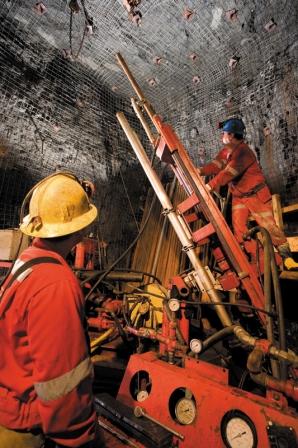
3. Lucara Diamond Corp. (TSX:LUC)
In March 2011, Lucara Diamond confirmed it was in talks with several companies in the diamond sector, including Gem Diamonds as it was evaluating merger alternatives. At the time, Gem Diamonds issued a somewhat prophetic statement, “These discussions are at a very early stage and there can be no certainty the contemplated merger will occur or of the timing or terms of any such transaction.”
At the time of the statement Cormark Securities analyst Matthew O’Keefe said, “I would take their press release at face value. This is a small space, everybody knows everybody else and they talk all the time.” By May, 2011 Gem Diamonds confirmed in a statement that discussions between the two companies had ended.
Lucara Diamonds is part of Lukas Lundin’s mining empire. The company has two key assets, specifically, the AK6 diamond mine in Botswana and the Mothae diamond mine in Lesotho. The 100% owned AK6 project is in the construction stage with mine, originally scheduled for commissioning to commence in the fourth quarter of 2011, now delayed until early 2012. The 75% owned Mothae mine is currently in the trial mining stage. Lucara also has a 49% interest in the Kavango diamond project in Namibia through it’s subsidiary Motapa.

In January earlier this year, Lukas Lundin, chairman of Lucara Diamond bought 215,000 shares in the public market between the prices of $1.05 and $1.10. He added to his position following the news of diamond sales from the company’s Mothae mine in Lesotho. Then on March 29 and 30, he bought one million shares in the public market at $1.20. We also note that in late February, chief executive officer William Lamb, the company’s President & CEO exercised 100,000 options and did not subsequently sell any shares. And a quick check on Canadian Insider shows more recent purchases at lower prices. Today, Lucara’s shares are trading just above 52 week lows at $0.83 resulting in a moderate paper-loss for the company’s Chairman.
I guess Mr. Lundin has been reading Suze Orman who writes, “By using the dollar-cost averaging technique, even if you’re investing for the long run (ten years or more), in the end you’ll be a winner.” Should we send Suze an email reminding her that not every stock goes up?
4. Mountain Province Diamonds Inc. (TSX:MPV)
On September 24th, 2010 Mountain Province Diamonds announced the results of the Feasibility Study on the Gahcho Kué diamond project located in Canada’s Northwest Territories. The study confirmed an operating mine life of 11 years based on an average annual production of approximately 4.5 million carats and initial capital costs in the range of $550 to $650 million. Thereafter, the company promptly raised $23 million at $5 per share providing the Mountain province with sufficient funds for its 2011 operating budget and a required $10 million payment to De Beers.
In partnership with De Beers, Mountain Province is developing, according to the company, the world’s largest and richest new diamond mine. And after 17 long years of development, the company is moving closer and closer towards production. De Beers is the world’s leader in diamond discover, development and mining. De Beers has been active in Canada since the early 1960s and is currently working on several exploration projects ranging from grassroots exploration to feasibility studies. De Beers Canada now has two established mines – the Snap Lake Mine and Victor Mine. Both mines were officially opened in July, 2008.
The Snap Lake Mine, De Beers’ first diamond mine outside of Africa, is built on the shore of Snap Lake 220 kilometres northeast of Yellowknife. The mine is Canada’s first completely underground diamond mine. While the Victor Mine is located in the James Bay Lowlands of Northern Ontario, approximately 90 kilometers west of the coastal community of Attawapiskat. Like Snap Lake, Gahcho Kué is located in Canada’s arctic.
Cathie Bolstad, spokesperson for De Beers Canada points out, different physical profiles of Snap Lake and Gahcho Kué will require different mining approaches. Whereas Snap Lake is a fully underground mine, Gahcho Kué is more reminiscent of the Ekati and Diavik diamond mines, which began their lives as traditional open-pit operations.
MiningFeeds.com recently connected with Patrick Evans, President & CEO of Mountian Province Diamonds, to discuss the company’s relationship with De Beers and their corporate development plans – CLICK HERE – to read more.

5. Shore Gold Inc. (TSX:SGF)
The Fort à la Corne area of Saskatchewan hosts an extensive kimberlite field and is the site of Shore Gold’s Star diamond project. Over 70 kimberlites exist in the Fort à la Corne forest and over 70 percent of these have been shown to contain diamonds. To date, NI 43-101 compliant Mineral Resource estimate for the explored portion of the Star Kimberlite is 20.5 million indicated carats and 3.1 million inferred carats. Total probable mine reserves of estimated at 34.4 million carats.
The past decade has been a wild ride for shareholders of Shore Gold. 10 years ago the company’s stock traded at $0.50 and, if I remember correctly, I purchased a private placement in the company at about that price. Five years later, when I was no longer a shareholder, shares of Shore Gold hit $8 a share. And now today, five years later, the company’s shares are again at $0.50. But as the quotable Baseball Hall of Fame catcher Yogi Berra once said, “It’s tough to make predictions, especially about the future.”
Predictions difficult? Barry Allan, senior analyst with Mackie Research would probably agree. Mr. Allan noted, “When Shore Gold originally discovered the kimberlites in the Fort a la Corne region… there were considerable question marks about whether there was potential for an economic diamond mine in Saskatchewan. The reason for that is these are somewhat different kinds of kimberlite or diamond inference kimberlite occurrences in the world — in the sense that they’re very different from what you find in other regions of Canada. They are very large, but relatively lower grade, compared to diamond deposits in Northern Canada, so the economic approach to exploiting these kinds of deposits is quite different.”
But after many years and many naysayers, Shore Gold released its Feasibility Study for the Star diamond project on July 14, 2011 confirming a NPV of $2.1 billion. But the massive scale and supporting economics may also be the biggest hurdle for the company when considering the up-front capital cost is expected to reach approximately $2 billion. For a company with a market cap of just over $100 million, accessing that amount of capital may prove somewhat challenging.
“It will take someone like Newmont Mining or (another) major mining company… someone like a BHP, Tech Cominco, or Rio Tinto to really have the horsepower. It will not be Shore Gold by itself,” said Mr. Allan. The Mackie Research analyst has a target price of $2 per share on the company’s stock assuming a “moneyed up, major mining company” steps in to help carry the ball across the goal line.
For 5 Diamond Stocks to Watch – Part 1 – CLICK HERE.



 Follow us on Twitter
Follow us on Twitter Become our facebook fan
Become our facebook fan











Comments are closed.